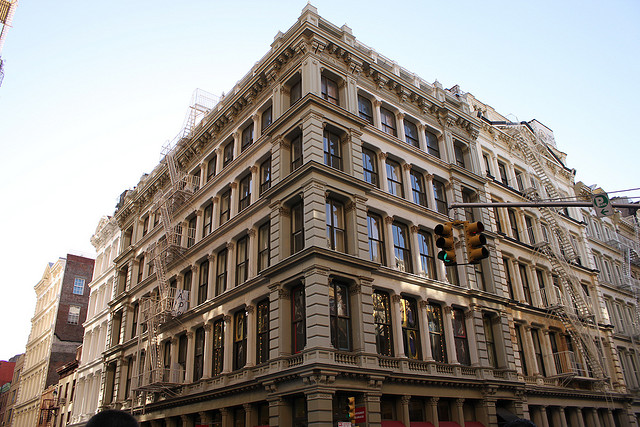| SoHo Cast Iron Historic District, Soho, Manhattan
The SoHo-Cast Iron Historic District lies in part within the western section of the Bayard Farm and during the 18th Century there was little change in its rural character.
This was due to the fact that it was cut off by natural barriers from the settlement at the lower tip of Manhattan. The Collect Pond and the stream flowing from it, Smith's Hill, Bayard's Hill and Lispenard's Meadow (Cripplebush Swamp) all combined to slow the northward expansion of the City. Broadway was not extended north of Canal Street until after 1775 and the surrounding land, even at this date, was still being farmed.
When the Revolution erupted, a series of fortifications and redoubts were built across Manhattan. There were two forts on Mercer Street between Broome and Spring streets; a third was located in the center of the block bounded by Grand, Broome, Mercer and Greene streets and another stood between Grand and Broome Streets, Broadway and Crosby Street.breastworks stretched across Broadway a few feet north of Grand Street.
The Early Republic
As a result of financial difficulties caused by the Revolutionary War, Nicholas Bayard, the third of that name, was forced to mortgage his West Farm. It was divider into lots at the close of the 18th Century but very little development took place until the first decade of the 19th Century.
As early as 1794, the area near the junction of Broadway and Canal Street had attracted a few manufacturing businesses. On the northwest comer of the intersection stood the cast-iron foundry and sales shop of Joseph Blackwell, wealthy Merchant and owner of Blackwell's Island.
Next to his property was that of y Thomas Duggan who owned a number of lots along Canal Street which was then called Dugyan Street. He operated a tannery near Blackwell's foundry.
By the early 1800s, landowners in the area had begun to petition the Common Council to drain and fill the Collect Pond, its outlet to the | 
